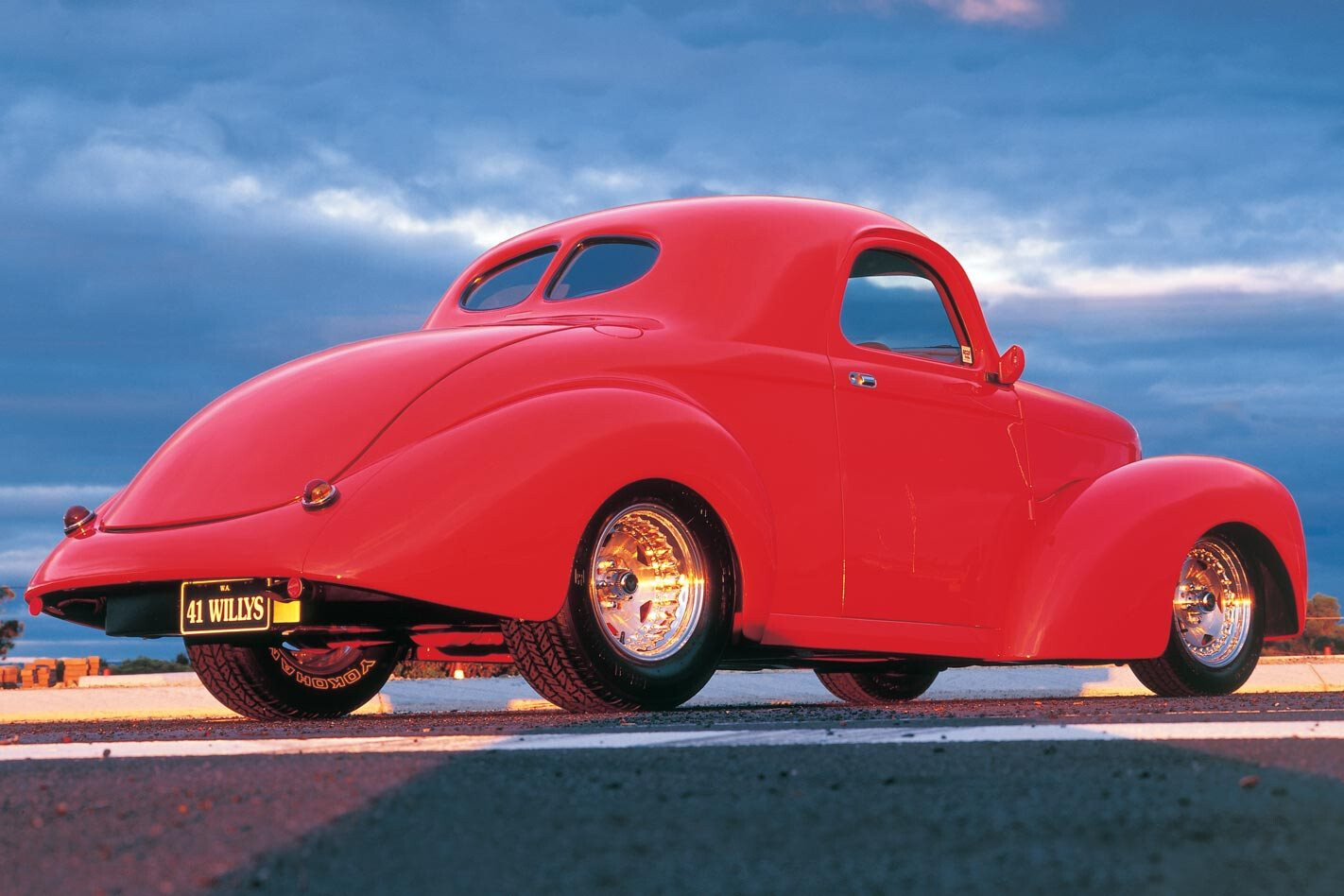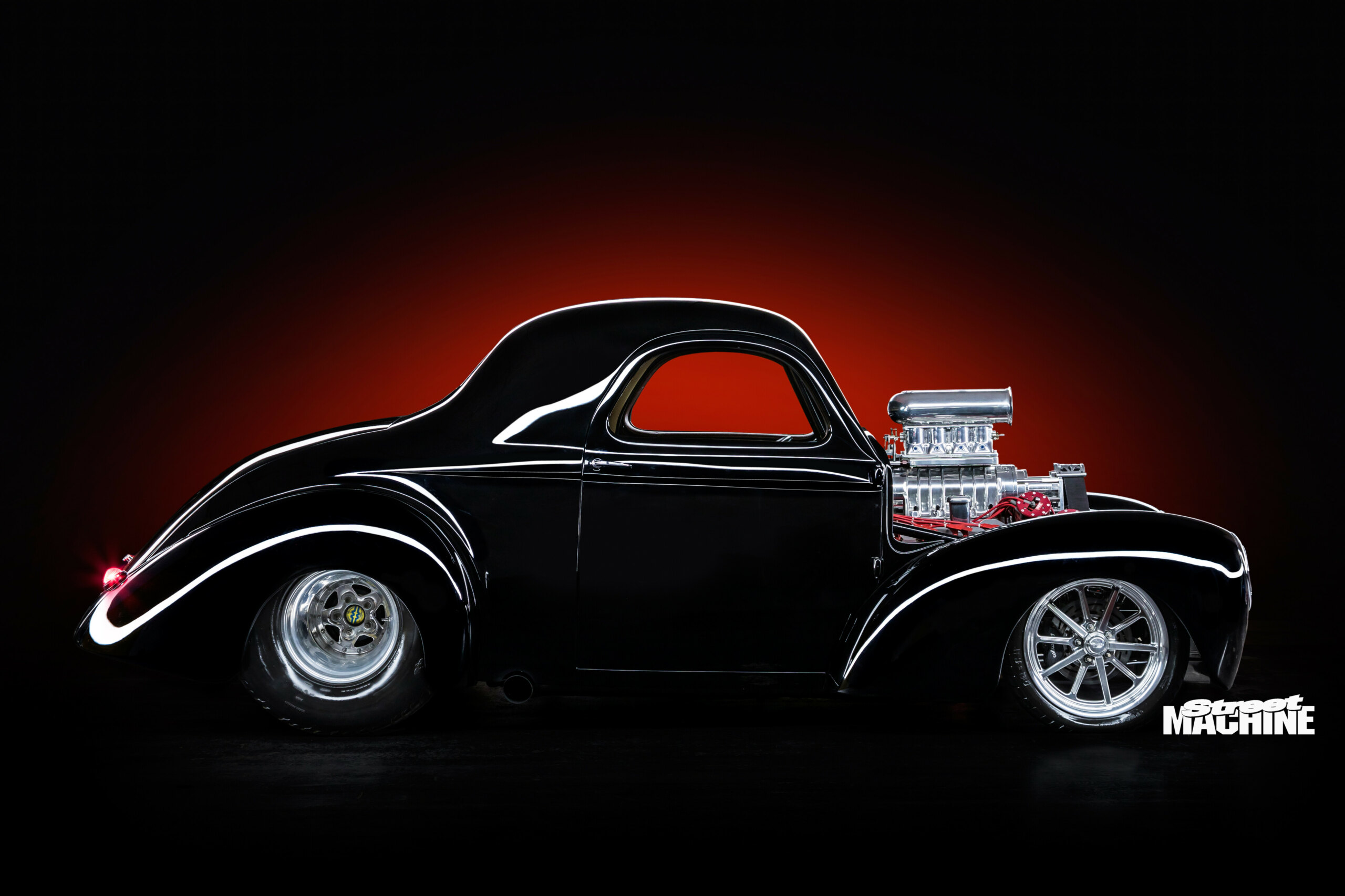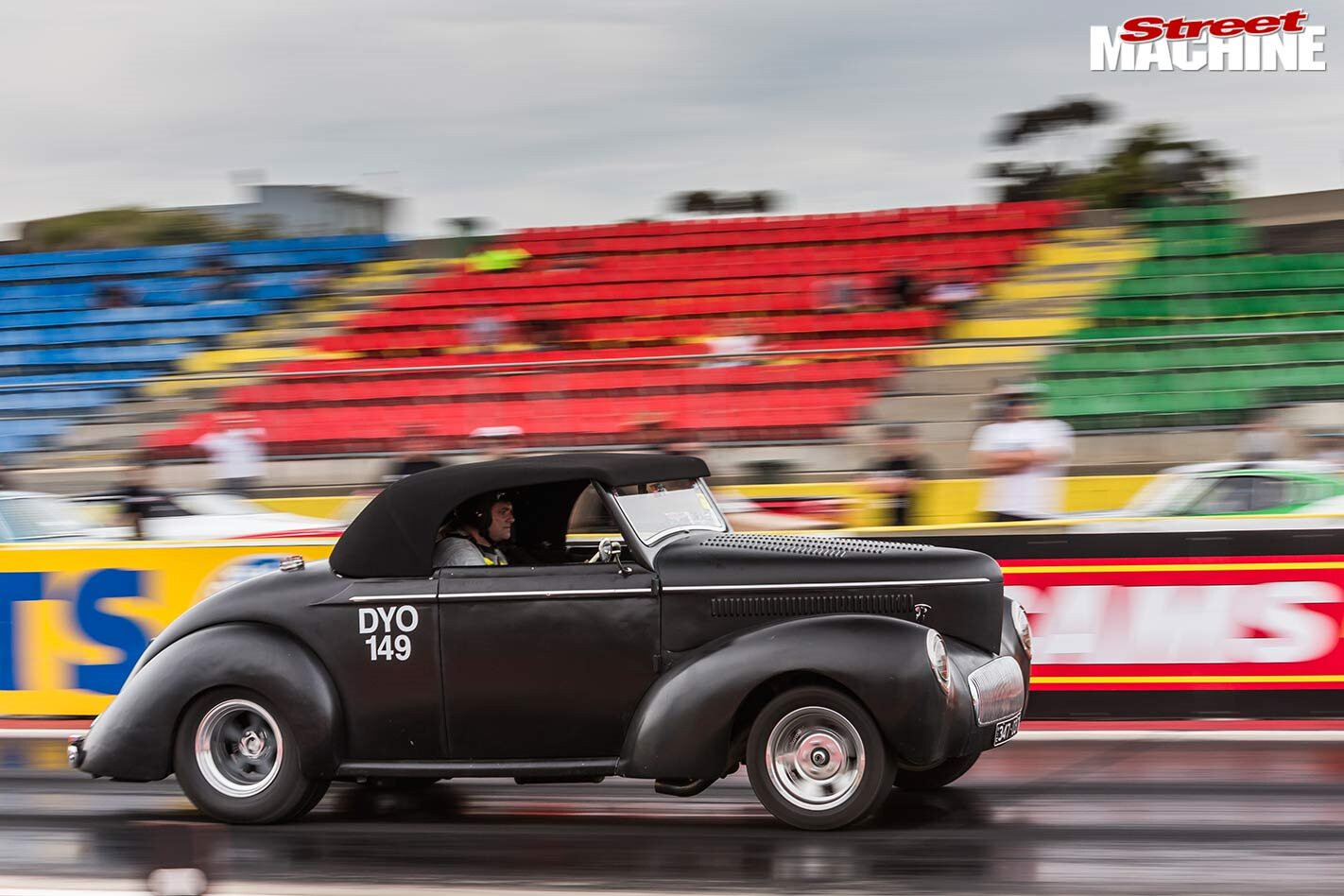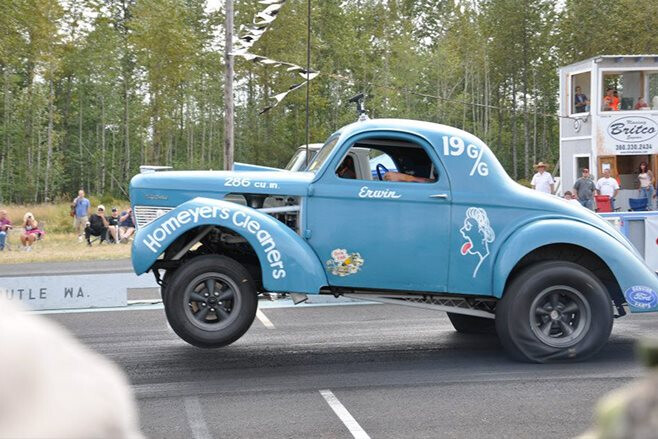This article on Mark’s 1941 Willys coupe was originally published in the March 2003 issue of Street Machine magazine
OWNING a classic rod like this 1941 Willys coupe makes a lot of sense to WA’s Mark Allen. That’s because he has a lot less hassle from the blokes with the blue lights. Ever since Mark switched from a traditional street machine to a rod, the bloke’s been enjoying a much happier relationship with the state’s notoriously tough coppers.
“I built a ute that was as modified as I could go without jeopardising the legal side of things,” Mark says. “I went for a rod because the (WA) police are more tolerant of street rods than street machines. A rod can legally have fat rear and skinny front tyres, a big motor, and so on.”
Funny that. We’ve heard this same argument from former street machiners-turned-rodders across the country. Just why the cops make such a distinction between a post-1948 sedan that’s been legally engineered and a pre-1948 version is beyond us. The fact is, responsible modified car lovers just want to be left alone to enjoy their wheel time on the streets and if owning a rod makes that little bit easier, well, then so be it.
“I chose a coupe over a convertible after my mates reminded me how sunburnt you can get when you’re cruising all day,” Mark says. “Besides, my dad has a 1968 big-block Pontiac Firebird convertible I can borrow.” Lucky sod!
Now don’t go thinking 29-year-old Mark towed a rusted-out hulk of a ’41 Willys from a farmer’s back paddock and built up a rod from scratch. Mark’s street ride is a fibreglass-bodied replica built up by former owner Chris Noble, which Mark has improved and upgraded since he took possession of the keys.
“I bought the car after looking at several rods,” Mark says. “It was something a bit different which I could finish off. The vehicle had to be well built and have a Chev or Holden motor, or at least be able to take a transplant because I’m not a Ford lover.”
Because Chris originally built the car, all the major problems had already been taken care of. Problems such as an ill-fitting fibreglass body, for instance. When Noble bought the New Zealand-made kit, it came as a main shell with guards, doors, boot and bonnet. According to Mark, things such as the guard flanges had to be completely ground off and re-glassed in new positions to make everything fit properly. In fact, the entire body structure needed a lot of surgery to make things line up the way they were intended.
The bodywork was prepped and sprayed in Hyundai Scarlet Red with a shot of clear on top. Mark and his dad have since given the skin a complete rub back to produce the mirror finish you see here.
The chassis is built from 150x50mm steel main rails with 100x50mm steel stock used to tie it all together. The front end uses LX Torana suspension, narrowed 100mm in track width and steered by a UC Torana rack and pinion. To get the nose riding where it should be, 50mm dropped front spindles from Castlemaine Rod Shop were installed, with Leyland P76 disc brakes and Monroe gas shocks to keep it under control.
The narrowed, 3.25-ratio nine-inch rear axle runs XB Falcon drums. It’s located by boxed LC Torana trailing arms, with Monroe shocks and Lovells springs to help it ride the bumps. The 15×6-inch front and 15×8½-inch rear CenterLine Convo Pro rims wear 205/60 and fat 275/60 Yokohama tyres.
Underneath the bonnet scoop beats the heart of a bee-yoo-dee-ful Bow Tie. None other than a classic 350 small-block punched out to 383 cubes, topped by an equally impressive sheetmetal intake manifold and twin 660cfm centre-squirter Holley carbs.
Dig deeper and you’ll discover a Crow cam and a stock conrod and crank combination working a set of forged TRW pistons, pumping 9.8:1 on LRP pump gas. A four-core Commodore V8 radiator backed by both a crank-driven fan and an auxiliary electric thermo unit easily keep the lid on coolant temperatures.
Mark changes ratios with a Turbo 350 auto, fitted with a ’74 Chev Vega shifter and mated to a 2200rpm stall converter. The big GM tranny also has a Stage Two Fairbanks shift kit and large-capacity Derale fluid pan to cope with serious abuse.
As you can see, the workmanship on this Willys is of a very high standard so you wouldn’t expect the interior to be anything less. Imagine building up a cockpit from scratch, starting with nothing more than a fibreglass shell and a steel chassis. There’s a few nice tricks in here. For instance, the whole dash has been extended 100mm towards the driver and passenger to allow enough clearance to install a Mazda 323 airconditioning system. The dash is a handmade creation, using Boyd Classic Series gauges and VL Commodore air vents. The Dashboard Exchange completed the superb finished moulding.
Windscreens O’Brien fabricated glass for the five window openings. The door glass slides up and down on electric power units supplied by Hot Rod Hardware and the internal door handle assemblies were adapted from a Mazda MX-5.
Keith Williams and Tim Broadhurst took on the colour-coordinated trim job, using a combination of beige moulded vinyls, velour and plush-pile carpet. Seats are VN Commodore with VR head rests and the tiller is a leather Lecarra unit, mounted to a Toyota Hilux steering column mated to a Torana collapsible section. There’s also a multi-speaker sound system hidden in there, thanks to Tim Broadhurst’s (Albert’s HiFi) stealth-like design and installation skills.
No doubt about it, this is one of WA’s finest street rods and the proof is, in Mark Allen’s case, on the mantelpiece. The Willys’ first show was Perth’s Motorvation in 2000 and Mark says he was as “happy as a dog with two dicks” to pick up four major Street Rod trophies including Best Engineered, Best Sedan/Coupe/Convertible, Best Interior and Best Judged.
Sort of says it all, doesn’t it?
MIX ‘N’ MATCH
The level of ingenuity rodders and street machiners display never ceases to amaze us when it comes to recycling old car parts into useful items on their build projects. Mark Allen’s Willys is a classic example of how a considered junkyard tour can result in a bootful of show-winning hardware.
Check out the shopping list on this jigger. The fuel lid, with remote cable and catch, is from a VN Commodore. Door handles are Mazda MX-5 and door catches are XF Falcon stock. Rear-view mirrors are motorcycle stuff. The boot catch is from a 1988 Ford Telstar and the boot stay is an original Willys item.
The fuel tank was originally an HJ Holden unit and that big fibreglass bonnet swings open on Mazda hatch hinges and stays shut with a Volvo bonnet catch. Waht was that old saying about everything old being new again?
BUT WAIT!
Some guys are never happy. As gorgeous as this Willys was at the time Street Machine photographed it, Mark was not entirely satisfied. With Summernats 15 quickly approaching, Mark decided to pull the Willys off the road and give it the once-over.
New additions include: moulding a completely new bonnet (with bonnet scoop), stroking the 350 out to 383 cubes and adding a sheet metal intake manifold topped with a pair of 660 Holleys. The block has been completely smoothed and deburred, underneath there’s a full 2½-inch mandrel-bent exhaust, while the TurboHydramatic 350 copped a full manual valvebody. Lastly some subtle panel imperfections in the boot lid were rectified.
For his efforts, Mark managed to snag Best Looking Club Vehicle and a spot in the coveted Elite Top Ten. Mark would like to extend a big thanks to his mum and dad for their considerable help, along with Mick from Fernihough Automotive and Mick from Avon Valley Spray Painting.
MARK ALLEN
1941 WILLYS COUPE
Colour: Hyundai Scarlet Red
GRUNT
Engine: Chev 383 stroker
Induction: Modified Quadrajet Rochester
Intake: Edelbrock Performer
Pistons: Forged TRW 9.8:1
GRIND
Gearbox: Turbo 350, Stage II Fairbanks shift kit
Convertor: 2200rpm stall
Diff: Narrowed nine-inch LSD 3.25:1
LUXURY
Seats: Retrimmed VN Commodore with VR headrests
Wheel: Leather Lecarra
Trim: Beige moulded vinyl
Instruments: Boyd Classic Series
ROLLERS
Wheels: 15×6 (f), 15×8½ (r) CenterLine Convo Pros
Tyres: 205/60 and 275/60 Yokohama 352s




Comments